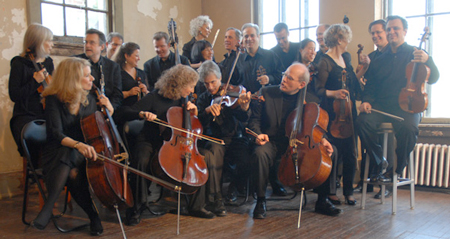by Jane Berkner

Eleven members of the ensemble played the first work, Concerto No. 3 in G. Even with the generous output of sound from this small group, discerning clarity and subtleties in this setting was not always possible. The musicians helped the situation tremendously by playing with great energy and zest, often with a forceful, muscular shaping of the lines that helped clarify their Baroque stylization. The cellos and bass did their part by keeping the group on task with a driving tempo. With the addition of rain during the performance, the sound of the harpsichord became non-existent.
The instrument’s reflective lid was added for Concerto No. 5 in D, which helped the projection considerably. Performing with great style, solo harpsichordist Bradley Brookshire was joined by violinist Renée Jolles and flutist Elizabeth Mann, both of whom played with big, warm sounds that carried relatively well in the pavilion. The second-movement trio was beautifully performed, with a flowing tempo and great attention to precise ensemble, articulation, and sculpting of phrases. The return to tutti in the third movement was played with lots of buoyant and danceable character by all. Though the rain had ceased by this point, the chorus of crickets, usually a joy to hear in outdoor concerts, saturated the air.
Orpheus’s viola section made their presence known from the very beginning of the concert, their strong and beautiful voices surging as lines were passed within the orchestra. In Concerto No. 6 in B-flat, they moved to the top of the score in a work composed entirely without violins. Although each of the two solo violas possessed a remarkably distinct sound, they performed together with a pleasing blend. Unfortunately, the dark sonority of this work sounded muddy in the acoustic of the large pavilion.
The scoring of solo violin, flute, oboe, and trumpet on the final work, Concerto No. 2 in F, brought definition to the sound of the Chamber Orchestra and created a joyful, well-balanced resolution to the program. Orpheus is famously led from within by a democratic process that moves musicians around the orchestra, exposing the wonderful diversity of voices from inside their ranks. Taking the solo violin position, Kyu-Young Kim was a commanding leader with a prodigious yet sprightly voice. The daunting trumpet part was artfully executed by Carl Albach.
The evening ended with an encore, a quiet and elegant rendering of the “Air” from Bach’s Orchestral Suite No. 3 in D.
Published on ClevelandClassical.com August 30, 2016.
Click here for a printable copy of this article



